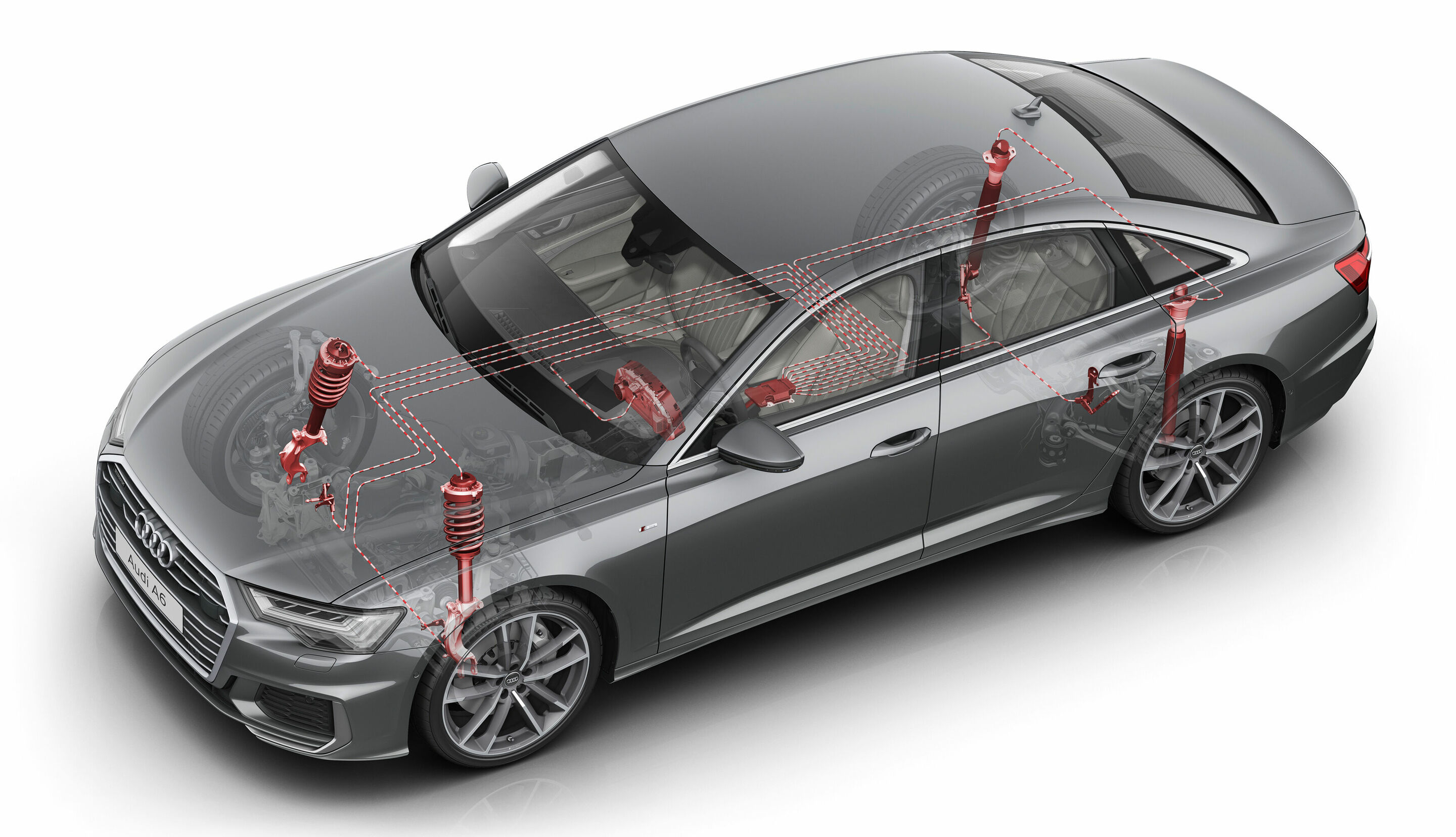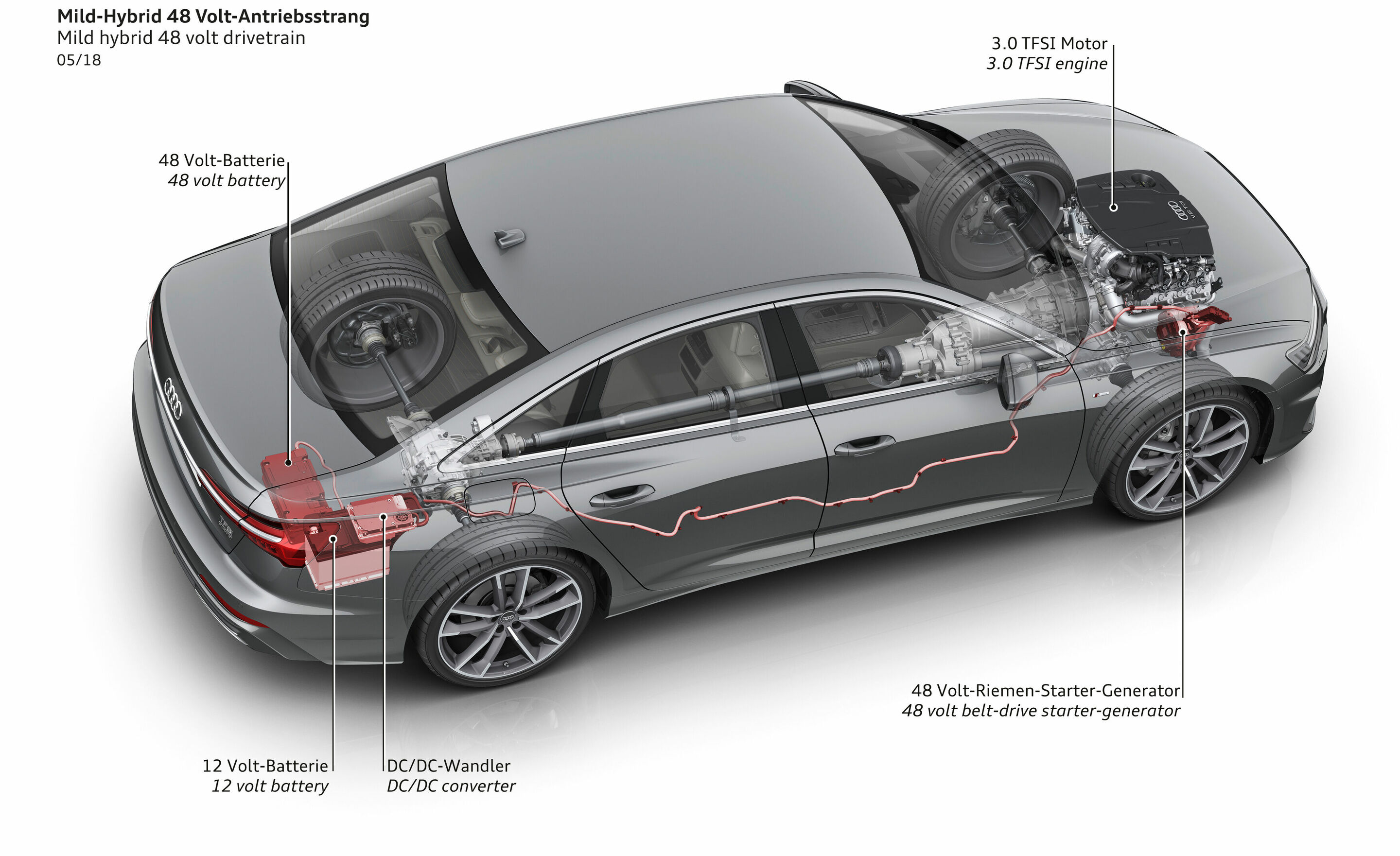SPORTINESS
Back to overviewAn extensive lineup of suspension technologies with the top-of-the-line innovation dynamic all-wheel steering makes the Audi A6 more agile and sportier than ever – while also enhancing comfort. Powerful, efficient engines deliver impressive performance.
Suspension
Even the predecessor model ranked among the sportiest cars in the business class. The new A6 Sedan is noticeably even more agile, while comfort and handling stability have been improved further. The new Audi A6 comes standard with the progressive steering. With a generally sporty steering ratio, it becomes increasingly direct with increasing steering angle. Its electromechanical power assistance transfers useful information to the driver, yet eliminates unpleasant jolts. This provides a direct connection between steering wheel, wheels and road.
The optional dynamic all-wheel steering in the Audi A6 is unrivaled among the competition. It resolves the conflict of objectives between spontaneous steering response and superb handling stability. The system combines dynamic steering at the front axle, which uses an infinitely variable strain wave gearing, with a separate rear axle steering system with a spindle drive and track rods. As such, the steering angle at the front and rear axle can be adjusted independently of each other. At speeds up to 60 km/h (37.3 mph), the rear wheels are turned as much as five degrees in the opposite direction in relation to the front wheels. This reduces the turning circle by up to one meter (3.3 ft) to 11.1 meters (36.4 ft), virtually on a par with the A3. As such, the approximately five-meter long (16.4 ft) Sedan is much more agile in urban traffic, on tight hairpin bends and while parking. At medium and high speeds, the wheels are turned by as many as two degrees in the same direction. Consequently the new Audi A6 is even more stable on the road and also performs abrupt evasive maneuvers with composure. Overall the superimposed steering at the front axle can vary the ratio between 9.5:1 and 16.5:1.
The front and rear axles of the new Audi A6 use a five-link design made extensively from aluminum. Two subframes – the front rigid, the rear hydraulically mounted – attach the links to the body. The front track is 1,630 millimeters (5.35 ft) wide, the rear 1,617 millimeters (5.31 ft).
The standard tuning is balanced – sporty and comfortable at the same time. There is a choice of three alternatives. Sport suspension lowers the body by 20 millimeters (0.8 in). It is available separately or together with 19-inch wheels in the S line sport package.
The suspension with damper control, the second option, comes with comfortable tuning despite the body being lowered by 10 millimeters (0.4 in). Its management is energy-efficient: higher power is only provided if the valves are closed to firm up the dampers.
The third option is the particularly comfortable adaptive air suspension, also with controlled damping. It can be set to several modes and incorporates level control. In the normal position, the body is 20 millimeters (0.8 in) lower than with the standard suspension, at speeds above 120 km/h (74.6 mph) it lowers the body a further 10 millimeters (0.4 in), which reduces the vehicle’s center of gravity and further improves aerodynamics and stability. The bellows of the air springs are made from natural rubber and are filled with carbon air, all of which gives them a highly sensitive response.
The controlled dampers, adaptive air suspension, dynamic all-wheel steering and the sport differential are managed by the electronic chassis platform (ECP), another major innovation in the new Audi A6. As the central suspension controller, the ECP collects comprehensive information about the movement of the car and the data from the systems involved. From these, it quickly calculates and closely coordinates the optimal function of these components in an integrated handling controller.
Whether cornering behavior, transverse dynamics or ride comfort – the advantages of the highly networked control system can be felt everywhere. In addition, the driver can himself adjust the settings with the Audi drive select dynamic handling switch for all controlled suspensions, with a choice of comfort, auto and dynamic modes. The driver experiences a new, additional spread between comfort and sport than on the predecessor – even the dynamic all-wheel steering varies its ratio and the degree of feedback.
The wheel lineup starts with the aero wheels in the sizes 17 and 18 inches. From the 19-inch format, torus absorbers – foam pads glued into the tires – reduce unwanted droning frequencies. The standard wheels measure 8.5 J x 21 and are equipped with 255/35 tires. If a wheel has been fitted loosely, say after changing tires, a warning comes on in the ESC – a unique function in the market.
Brakes with fixed calipers made from aluminum at the front, each with six brake pistons, deliver outstanding deceleration figures. The front discs measure 375 millimeters (14.8 in) in diameter on the 3.0 TFSI (rear: 350 millimeters / 13.8 in) and combine cast friction rings with aluminum brake pots. Electronic Stabilization Control (ESC) provides even more precise control than in the previous model.
Powertrain
For the market introduction of the new Audi A6 in Europe in July the engine range will feature three turbocharged engines – one gasoline unit and two diesel engines.
All engines have been developed from scratch or partially upgraded and stand out with their outstanding power delivery, refinement and efficiency. Other four-cylinder engines, in gasoline and diesel versions, will join the lineup in the course of the year.
In the Audi A6 55 TFSI (combined fuel consumption in l/100 km: 7.1 – 6.7 (33.1 – 35.1 US mpg)*; combined CO2 emissions in g/km: 161 – 151 (259.1 – 243.0 g/mi)*), the 3.0 TFSI produces 250 kW (340 hp) and delivers 500 Nm (368.8 lb-ft) of torque over a broad band from 1,370 to 4,500 rpm. It accelerates the business-class sedan from 0 to 100 km/h (62.1 mph) in 5.1 seconds, and its top speed is electronically limited to 250 km/h (155.3 mph).
The new three-liter V6 gasoline unit with its aluminum crankcase weights just 172 kilograms (379.2 lb). Its exhaust end lies inside the 90° vee, so the short gas paths and the twin scroll charger guarantee spontaneous responsiveness. The B cycle combustion process – an Audi development – ensures superb efficiency. To support it, the Audi valvelift system (AVS) adjusts the intake valves in two stages based on load and engine speed. Another efficiency element is thermal management with its separate cooling loops for the crankcase and cylinder head. The exhaust manifold is integrated into the cylinder head; this helps the engine heat up quickly after a cold start.
The Audi A6 55 TFSI (combined fuel consumption in l/100 km: 7.1 – 6.7 (33.1 – 35.1 US mpg)*; combined CO2 emissions in g/km: 161 – 151 (259.1 – 243.0 g/mi)*) is fitted with a seven-speed S tronic and uses the quattro with ultra technology. It offers maximum efficiency and does not perceptibly differ from permanent systems in terms of traction and driving dynamics. As long as the Sedan is being driven with moderate gear changes and there is no risk of tire slip, the system uses the economical front-wheel drive. If all-wheel drive is required, a clutch instantly activates it, in many cases and in certain situations even predictively. The quattro with ultra technology also works together with the wheel-selective torque control.
The 3.0 TDI in the Audi A6 50 TDI (combined fuel consumption in l/100 km: 5.8 – 5.5 (40.6 – 42.8 US mpg)*; combined CO2 emissions in g/km: 150 – 142 (241.4 – 228.5 g/mi)*) produces 210 kW (286 hp) and delivers 620 Nm (457.3 lb-ft) of torque, the latter between 2,250 and 3,000 rpm. The standard sprint takes 5.5 seconds and the top speed of 250 km/h (155.3 mph) a mere formality. Fuel consumption is just 5.5 liters per 100 km (42.8 US mpg), which equates to CO2 emissions of 142 grams per kilometer (228.5 g/mile).
The 3.0 TDI stands out with its myriad high-tech solutions. Its sophisticated thermal management includes separate cooling loops for the crankcase and cylinder heads, the water jackets in the head feature a two-part design. Cast-in channels cool the pistons with oil. Their rings and the wrist pins are designed for minimum friction; the oil pump is fully variable. Thanks also to the crankcase made from lightweight cast iron with vermicular graphite, the powerful diesel unit weights just 190 kilograms (418.9 lb).
Audi A6 | 55 TFSI (3.0 TFSI) | 50 TDI (3.0 TDI) | |||
Displacement | 2,995 | 2,967 | |||
Max. power output | 250 (340) | 210 (286) | |||
Max. torque | 500 (368.8) | 620 (457.3) | |||
Top speed | 250 (155.3) | 250 (155.3) | |||
Acceleration | 5.1 | 5.5 | |||
Fuel consumption (combined) | 6.7 – 7.1 (33.1 – 35.1)* | 5.5 – 5.8 (42.8 – 40.6) | |||
Combined CO2 emissions | 151 – 161 | 142 – 150 | |||
Powertrain | quattro | quattro | |||
* Figures depend on the tire/wheel sets used
An eight-speed tiptronic, which provides smooth, rapid gearshifts, is used to transfer the power on the V6 TDI. When coasting and rolling out, a clutch in the central transmission opens and interrupts the power connection. An electric oil pump makes it possible for the tiptronic to engage the gear that will be needed after the rolling phase. An rpm-adaptive torsion damper with a centrifugal force pendulum largely compensates for undesirable vibrations in the engine; this permits driving from an engine speed range as low as 1,000 revolutions per minute. The 3.0 TFSI is paired standard with a seven-speed S tronic. It also features a centrifugal force pendulum. Two electric oil pumps and an accumulator ensure gearshifts while the vehicle is coasting or stationary.
Depending on the transmission, Audi fits the standard quattro drive in different variants. In conjunction with the eight-speed tiptronic it is a purely mechanical version. Its self-locking center differential normally distributes the torque in a ratio of 40:60 between the front and rear axle. If the grip fades on one axle, it can be sent up to 70 percent forward and a maximum 85 percent to the rear. All seven-speed S tronic transmissions use the efficient quattro all-wheel drive with ultra technology, which instantly activates the rear axle where necessary.
With a sporty driving style, the wheel-selective torque control of the sport differential rounds out the handling by slightly braking the near-side wheels before they slip and can thus lose lateral stability.
The optional sport differential at the rear axle is another supplement for the quattro permanent all-wheel drive in the V6 diesel engines – when cornering at speed the sport differential forwards the bulk of the torque to the far-side wheel that has more traction.
All terms marked in the text are explained in detail in the technology lexicon at www.audi-mediacenter.com/en/technology-lexicon.
The equipment, data and prices specified in this document refer to the model range offered in Germany. Subject to change without notice; errors and omissions excepted.

